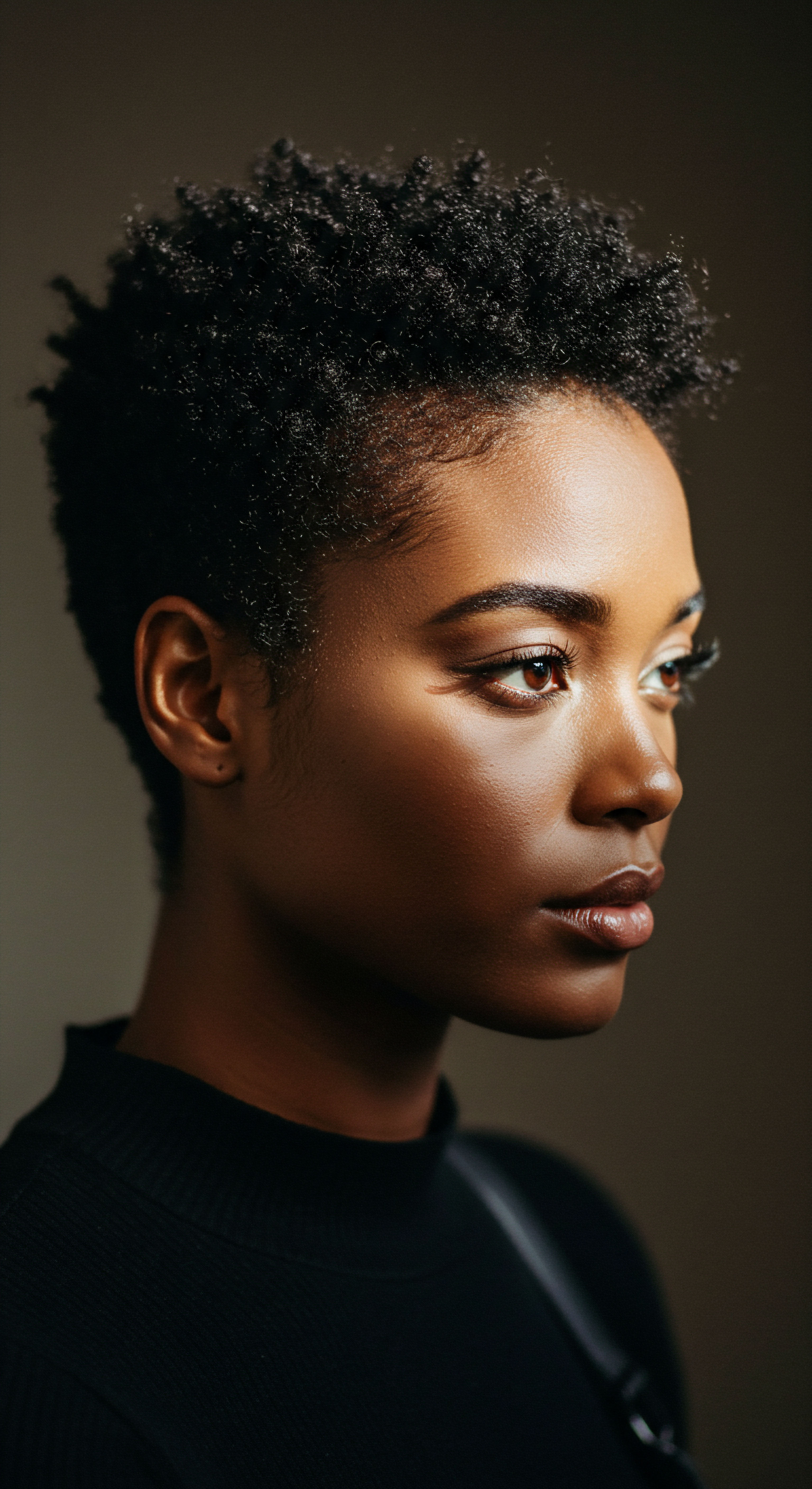
Roots
A quiet hum exists beneath the surface of our modern routines, a gentle whisper from ages past. It speaks of a time when the earth itself was the apothecary, and the wisdom of caring for our strands flowed directly from the living world. How do these ancestral practices, often perceived as relics of a distant past, truly align with the urgent call for environmental responsibility today?
The answer lies not in a simple comparison, but in recognizing a deeply embedded reverence for natural cycles, a resourcefulness born of necessity, and an understanding of hair as a part of the greater ecological system. This connection, subtle yet profound, invites us to look beyond the immediate and consider the enduring legacy of traditional hair care.

Ancient Wisdom of Botanical Care
Across continents and cultures, the botanical world provided the primary ingredients for hair care. Indigenous communities possessed a deep, inherited knowledge of local flora, discerning which plants offered cleansing properties, which could condition, and which imparted vibrant color or strength. This understanding was not merely utilitarian; it stemmed from a respectful relationship with the land, recognizing plants as providers. For example, the use of Soapberries (Sapindus mukorossi) in parts of Asia and North America, or Rhassoul Clay from the Atlas Mountains of Morocco, served as natural cleansing agents.
These substances, derived directly from the earth, returned to it without harm, completing a cycle of use and replenishment. The practices prioritized what was locally abundant and seasonally available, reducing the environmental strain associated with distant sourcing and industrial processing.
Traditional hair practices often mirrored the natural world’s cycles, drawing directly from botanical abundance for cleansing and nourishment.
This approach stands in stark contrast to the complex, often resource-intensive supply chains of many contemporary hair products. When communities gathered their ingredients, they were intimately aware of the plant’s life cycle, ensuring sustainable harvesting that allowed populations to regenerate. The wisdom passed down through generations ensured that the ecological balance remained undisturbed, a symbiotic relationship where human needs were met without depleting the source.

Resourcefulness in Hair Rituals
Beyond ingredients, the very rituals of traditional hair care demonstrated an inherent resourcefulness. Water, a precious commodity in many regions, was often used sparingly, or collected and reused. Cleansing might involve minimal water application, focusing instead on manual scalp stimulation or dry cleansing methods using powders. Styling often leaned towards long-lasting protective styles, such as Braids, Locs, or Twists, which reduced the frequency of washing and product application.
This longevity minimized daily water and energy consumption, and lessened the overall demand for new products and their associated packaging. The tools employed were similarly simple and often crafted from natural, renewable materials, like wooden combs or animal bone pins, which could be repaired or returned to the earth at the end of their useful life.
Consider the practice of creating natural oils and butters from locally sourced seeds, like shea butter in West Africa or coconut oil in tropical regions. These processes were often communal, low-energy, and produced minimal waste. The byproducts were frequently repurposed, perhaps as animal feed or fertilizer, embodying a circularity that modern industrial systems often struggle to replicate. This holistic perspective, where nothing was truly wasted, extended the environmental alignment beyond just the initial sourcing of ingredients.

The Sacred Connection to Earth
For many traditional cultures, hair held profound spiritual and cultural significance, often seen as an extension of the self and a connection to ancestry and the divine. This reverence extended to the earth from which hair care provisions were drawn. The act of gathering herbs or clays became a ritual of gratitude and respect. This deep spiritual connection fostered an inherent environmental stewardship.
When hair was considered sacred, the substances applied to it, and the methods used to care for it, were chosen with mindfulness, recognizing their origins and their ultimate return to the earth. This philosophy inherently discouraged waste and promoted a gentle interaction with the natural world, reinforcing sustainable practices not as a chore, but as an act of devotion.
This profound link between hair, identity, and the environment is a cornerstone of understanding how traditional practices inherently leaned towards ecological balance. It suggests that sustainability was not a separate concept to be added later, but an intrinsic aspect of the cultural framework surrounding hair.

Ritual
Stepping from the foundational wisdom of our roots, we arrive at the practical cadence of ritual, where daily choices and periodic customs shape our interaction with the world. How do the rhythms of traditional hair care, the careful preparations and thoughtful applications, translate into tangible benefits for our planet? It involves a conscious movement away from the transient and towards the enduring, a shift in perspective that views each act of care as an opportunity for mindful consumption and environmental consideration. This segment seeks to illuminate the applied wisdom of traditional practices, offering a gentle guide through their ecological resonance.

Mindful Cleansing and Conditioning
The act of cleansing hair in traditional contexts frequently differed significantly from the modern daily shampooing routine. Rather than stripping strands with harsh detergents, historical methods often prioritized gentle, infrequent cleansing using naturally derived surfactants or clays. This approach had direct environmental benefits. Reduced washing frequency means less water consumption.
A study from Sheffield Hallam University highlighted that showering and bathing contribute significantly to daily domestic water consumption, with typical showers using substantial volumes per minute. By extending the time between washes, traditional practices inherently conserved this vital resource.
Furthermore, the ingredients used in traditional cleansing, such as plant-based saponins or mineral-rich clays, were biodegradable, ensuring that what went down the drain returned to the earth without leaving behind persistent chemical pollutants. Modern products, conversely, can introduce a complex array of synthetic compounds, including sulfates, parabens, and artificial fragrances, which may harm aquatic ecosystems when they enter waterways.
The mindful rhythms of traditional hair cleansing often translated directly into reduced water consumption and minimized chemical runoff.
Conditioning, too, followed a pattern of minimal processing and direct application of natural emollients. Oils from seeds, nuts, and fruits – think Jojoba, Argan, or Coconut Oil – were used in their pure, unrefined states. This avoided the energy-intensive manufacturing processes associated with many synthetic conditioners and minimized the need for complex packaging. The emphasis was on nourishment that worked with the hair’s natural properties, rather than imposing artificial textures or appearances through chemical means.

Styling with Nature’s Rhythm
Traditional styling practices often centered on protective styles that served multiple purposes ❉ safeguarding the hair, expressing cultural identity, and extending the time between washes. Styles like Cornrows, Box Braids, or Thread Wraps, common across African and diasporic cultures, could last for weeks or even months. This extended wear dramatically reduced the need for daily styling products, heat tools, and the associated energy consumption.
The environmental footprint of a daily styling routine, with its array of sprays, gels, and heated appliances, accumulates rapidly. By contrast, traditional protective styles, while requiring initial time and skill, significantly lowered the ongoing environmental demand.
Even when heat was applied, it was often through indirect methods, such as sun-drying or warm cloths, which consumed no external energy. The tools themselves, often hand-carved combs or simple pins, were durable and designed for longevity, contrasting sharply with the disposable plastic accessories and electronic devices prevalent today.
| Practice Aspect Cleansing Agents |
| Traditional Approach Natural botanicals, clays (e.g. Shikakai, Rhassoul) |
| Modern Conventional Approach Synthetic detergents, chemical compounds |
| Practice Aspect Water Usage |
| Traditional Approach Infrequent, mindful application, often reused |
| Modern Conventional Approach Frequent, high-volume showering |
| Practice Aspect Product Packaging |
| Traditional Approach Minimal, biodegradable (leaves, gourds, direct plant use) |
| Modern Conventional Approach Predominantly single-use plastic bottles |
| Practice Aspect Styling Tools |
| Traditional Approach Durable, natural materials (wood, bone), hand-crafted |
| Modern Conventional Approach Disposable plastic, energy-intensive electrical appliances |
| Practice Aspect Style Longevity |
| Traditional Approach Long-lasting protective styles (braids, locs) |
| Modern Conventional Approach Frequent restyling, often daily |
| Practice Aspect This table highlights the general alignment of traditional hair care practices with environmental sustainability, contrasting them with typical modern methods. |

The Lifecycle of Hair Tools
The materials and durability of hair tools offer another lens through which to view environmental alignment. Traditional tools, crafted from materials readily available in the local environment, possessed an inherent circularity. A wooden comb, carved from a fallen branch, could be sanded and reused for decades, perhaps even passed down through generations. Should it break, it would return to the earth without contributing to persistent pollution.
- Natural Materials ❉ Traditional combs, picks, and styling implements were often made from wood, bone, or horn, materials that degrade naturally.
- Durability ❉ These tools were designed for longevity, reducing the need for frequent replacement and subsequent waste.
- Repairability ❉ Simple construction meant that many traditional tools could be repaired rather than discarded, extending their lifespan.
This contrasts with the contemporary landscape dominated by plastic combs, brushes, and styling accessories, many of which are designed for disposability or break easily. The environmental burden of plastic production, its reliance on petroleum, and its persistent presence in landfills and oceans, casts a long shadow over modern hair care. The shift from a mindset of creating and maintaining tools to one of constant consumption and disposal has tangible ecological consequences.

Relay
Having explored the foundational principles and daily practices, we now move to a deeper consideration, a relay of understanding that bridges scientific insight with profound cultural context. How do traditional hair practices, when viewed through a sophisticated lens, truly contribute to ecological well-being beyond simple resource conservation? This segment invites a nuanced examination, drawing upon research and data to illuminate the complex interplay of biological, social, and environmental factors at play. It asks us to consider not just what was done, but the deeper ‘why’ that underpinned sustainable choices.

Intergenerational Knowledge Systems and Sustainability
Traditional hair care was rarely documented in written texts; its wisdom resided within the collective memory of communities, passed from elder to youth, from mother to child. This oral transmission ensured that practices were deeply embedded in local ecological realities. Knowledge about the optimal time to harvest a particular plant, the specific soil conditions it needed, or the amount that could be gathered without harming its population, was integral to the teaching. This living library of environmental understanding meant that sustainability was not a policy to be enforced, but a communal ethos to be upheld.
The continuity of these knowledge systems allowed for practices to adapt organically to environmental shifts over centuries, creating a resilient and responsive approach to resource management. When compared to the often-fragmented knowledge systems of modern industry, where information about sourcing and impact can be opaque and disconnected from the end-user, the clarity and directness of traditional intergenerational learning stand out.

Does Modern “Natural” Hair Care Truly Align with Traditional Ecological Principles?
A significant point of discussion arises when modern “natural” or “clean beauty” movements attempt to replicate traditional practices. While commendable in their intent, these efforts can sometimes miss the core environmental alignment if they overlook the crucial aspect of localized sourcing and circularity. The contemporary demand for ingredients like shea butter or argan oil, traditionally harvested and processed within specific communities, has led to globalized supply chains. While these ingredients themselves are natural, their transportation across vast distances, often involving industrial processes, can significantly increase their carbon footprint.
For instance, a 2024 study on the environmental impact of cosmetic packaging noted that plastic bottles are a primary culprit in the industry’s carbon footprint, and that traditional, localized methods often circumvented the need for such extensive packaging. This research highlights that while a product may contain natural ingredients, its packaging and supply chain can still present a considerable environmental burden. The Ellen MacArthur Foundation’s 2019 Global Commitment report, while not specific to hair care, revealed that despite efforts, only a small percentage of plastic packaging is truly reused or recycled, with the majority still ending up as waste. This systemic challenge underscores a key divergence ❉ traditional practices often operated within closed-loop systems, minimizing external inputs and outputs, a stark contrast to the linear model still prevalent in much of the modern beauty industry.
The nuanced relationship between contemporary “natural” hair care and its traditional counterparts often hinges on the ecological implications of globalized supply chains and packaging.
The real environmental advantage of traditional methods extended beyond the ingredient itself to the entire ecosystem of its procurement and application. It was not just about the plant, but the local soil, the water source, the community’s labor, and the absence of distant shipping or single-use containers.

Biomimicry in Traditional Hair Care
Traditional practices often mirrored natural processes, acting as a form of biomimicry long before the term existed. Observing how plants self-cleanse or how animal coats maintain health in their natural habitats often inspired human hair care solutions. For example, the use of certain plant mucilages to provide slip and detangling agents in traditional hair rinses reflects the natural world’s own lubricating mechanisms.
This deep observational learning led to solutions that were inherently gentle on both hair and the environment. They respected the natural biology of the hair strand and scalp, working with its innate properties rather than against them. This contrasts with modern approaches that sometimes rely on chemical interventions to alter hair structure, often with environmental consequences during production and disposal.
- Plant-Based Cleansers ❉ Utilizing saponin-rich plants that create a gentle lather, mimicking natural cleansing processes found in some ecosystems.
- Natural Conditioning Agents ❉ Applying oils and butters directly from plants, drawing inspiration from how plants themselves protect their surfaces and retain moisture.
- Minimal Intervention ❉ Embracing hair’s natural texture and form, thereby reducing the need for chemical alterations or energy-intensive styling.

What Can Modern Hair Care Learn from Traditional Environmental Ethics?
The lessons from traditional hair practices extend beyond specific ingredients or techniques; they offer a profound ethical framework for environmental interaction. The underlying principle is one of deep respect for resources, an understanding of interconnectedness, and a commitment to waste reduction at every stage. This goes beyond mere “greenwashing” or superficial eco-friendly claims, reaching into the very ethos of production and consumption.
Modern hair care can draw upon this by prioritizing truly circular systems, investing in local and regenerative sourcing, minimizing packaging to an absolute minimum, and designing products that degrade harmlessly. It involves a shift from a consumerist mindset to one of stewardship, where the beauty of our hair reflects a deeper beauty in our relationship with the planet. This requires not just technological innovation, but a return to a mindful, holistic perspective that acknowledges the ecological cost of every product and practice.
| Aspect Ingredient Sourcing |
| Traditional Practices Local, wild-harvested, seasonal, low carbon footprint for transport. |
| Modern Conventional Products Globalized, often industrial farming, high carbon footprint from transport. |
| Aspect Manufacturing Energy |
| Traditional Practices Minimal, manual, community-based, low energy consumption. |
| Modern Conventional Products High, industrial-scale, reliant on fossil fuels for production. |
| Aspect Waste Generation |
| Traditional Practices Near-zero waste, biodegradable byproducts, reusable tools. |
| Modern Conventional Products Significant plastic packaging waste, chemical runoff, non-biodegradable ingredients. |
| Aspect Water Consumption |
| Traditional Practices Reduced frequency of washing, efficient use, often cold water. |
| Modern Conventional Products Frequent washing, high-volume showers, heated water use. |
| Aspect This table illustrates the broad differences in environmental impact between traditional and modern hair care approaches across several key metrics. |
The implications for environmental care are clear. By revisiting and adapting the core principles of traditional hair practices, we can move towards a beauty industry that not only celebrates our strands but also safeguards the delicate balance of our planetary home. The wisdom of the past, coupled with conscious innovation, holds the key to a truly sustainable future for hair care.

Reflection
As the light shifts, revealing new contours of understanding, we pause to consider the enduring echoes of ancestral hair practices. They are not merely historical footnotes, but vibrant blueprints for a future where personal care harmonizes with planetary well-being. The delicate dance between hair and earth, once an intuitive rhythm, now calls for a conscious re-engagement.
It is a quiet invitation to listen to the whispers of leaves, the murmur of streams, and the deep, grounding presence of the soil, recognizing that the beauty we seek for our strands is inextricably linked to the health of the world around us. This understanding beckons us towards a more gentle, more knowing way of being, where every choice in our hair journey contributes to a larger story of ecological balance and profound reverence.

References
- Ellen MacArthur Foundation. The New Plastics Economy Global Commitment 2019 Progress Report. Ellen MacArthur Foundation, 2019.
- Geyer, R. Jambeck, J. R. & Law, K. L. Production, use, and fate of all plastics ever made. Science Advances, 3(7), e1700782. 2017.
- Nirmalan, P. Ethnobotany of Cosmetics in the Northern Region of Sri Lanka. Journal of Medicinal Plants Studies, 5(1), 164-167. 2017.
- Pinho, A. L. R. & Ferreira, J. C. T. Innovation and Sustainability in the Supply Chain of a Cosmetics Company ❉ a Case Study. Journal of Technology Management & Innovation, 7(2), 144-156. 2012.
- Silva, N. & Pålsson, H. Industrial packaging and its impact on sustainability and circular economy ❉ A systematic literature review. Journal of Cleaner Production, 333, 130165. 2022.
- Tardío, J. & Pardo-de-Santayana, M. Cultural importance indices ❉ a comparative analysis based on the useful wild plants of Southern Cantabria (Northern Spain). Economic Botany, 62(1), 24-39. 2008.
- Veolia. Ellen MacArthur Foundation ❉ New Plastics Economy Global Commitment. Veolia. 2020.
- Ziane, M. & Cherkaoui, H. Ethnobotanical Survey of Medicinal Plants used in the Treatment and Care of Hair in Karia ba Mohamed (Northern Morocco). Journal of Pharmacognosy and Phytochemistry, 8(6), 1184-1188. 2019.